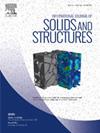A nonlinear unit cell for adaptive lattice structures with shape-memory-like behaviour
IF 3.8
3区 工程技术
Q1 MECHANICS
International Journal of Solids and Structures
Pub Date : 2025-05-05
DOI:10.1016/j.ijsolstr.2025.113411
引用次数: 0
Abstract
We present and classify a fundamental building block for constructing macro-scale lattice structures with shape-memory-like behaviour. Shape memory alloys (SMAs) are materials that undergo a reversible phase transition at the atomic scale from a high-symmetry crystal structure above a transition temperature to a lower-symmetry crystal structure below the transition temperature, thereby imbuing these alloys with superelastic properties and the ability to recover a previous shape when heated. We present a unit cell for creating latticed metamaterials at the macro- rather than the micro-scale that shows similar smart, adaptive behaviour in two and three spatial dimensions. Specifically, we study a square unit cell with rigid outer edges and two nonlinear springs on the diagonals that undergoes instabilities into planar, rhombic and/or non-planar, folded states. We identify two non-dimensional parameters that govern the planar multistable behaviour, and derive boundaries that split the domain into monostable (square cell), bistable (rhombic cell) and tristable (square and rhombic cells) regimes. Transitions between the square and rhombic configurations can be smooth/soft or sudden/hard. We illustrate how changes in the springs’ rest lengths and stiffness properties define the possible types of phase transitions, irrespective of the physical mechanisms (such as temperature, electromagnetic fields or swelling) driving those changes. In addition to planar multi-stability, we define the parameter regime wherein the initially planar unit cell can deform out of the plane.
具有形状记忆行为的自适应晶格结构的非线性单元胞
我们提出并分类了一个基本的构建块,用于构建具有形状记忆行为的宏观尺度晶格结构。形状记忆合金(sma)是一种在原子尺度上经历可逆相变的材料,从高于转变温度的高对称晶体结构到低于转变温度的低对称晶体结构,从而赋予这些合金超弹性性能和加热时恢复先前形状的能力。我们提出了一种用于在宏观而不是微观尺度上创建网格超材料的单元格,它在二维和三维空间中表现出类似的智能,自适应行为。具体来说,我们研究了一个具有刚性外缘和对角线上的两个非线性弹簧的方形单元胞,该单元胞经历不稳定进入平面、菱形和/或非平面折叠状态。我们确定了控制平面多稳定行为的两个非维度参数,并推导了将区域划分为单稳定(方单元),双稳定(菱形单元)和三稳定(方和菱形单元)的边界。正方形和菱形结构之间的转换可以是平滑/柔和的,也可以是突然/坚硬的。我们说明了弹簧的静止长度和刚度属性的变化如何定义相变的可能类型,而不考虑驱动这些变化的物理机制(如温度、电磁场或膨胀)。除了平面多重稳定性外,我们还定义了初始平面单元胞可以变形出平面的参数范围。
本文章由计算机程序翻译,如有差异,请以英文原文为准。
求助全文
约1分钟内获得全文
求助全文
来源期刊
CiteScore
6.70
自引率
8.30%
发文量
405
审稿时长
70 days
期刊介绍:
The International Journal of Solids and Structures has as its objective the publication and dissemination of original research in Mechanics of Solids and Structures as a field of Applied Science and Engineering. It fosters thus the exchange of ideas among workers in different parts of the world and also among workers who emphasize different aspects of the foundations and applications of the field.
Standing as it does at the cross-roads of Materials Science, Life Sciences, Mathematics, Physics and Engineering Design, the Mechanics of Solids and Structures is experiencing considerable growth as a result of recent technological advances. The Journal, by providing an international medium of communication, is encouraging this growth and is encompassing all aspects of the field from the more classical problems of structural analysis to mechanics of solids continually interacting with other media and including fracture, flow, wave propagation, heat transfer, thermal effects in solids, optimum design methods, model analysis, structural topology and numerical techniques. Interest extends to both inorganic and organic solids and structures.

 求助内容:
求助内容: 应助结果提醒方式:
应助结果提醒方式:


